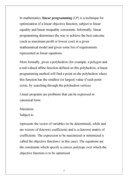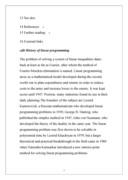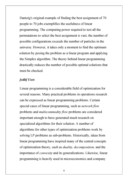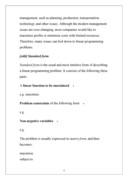بخشی از مقاله
مقاله ترجمه شده برنامهریزی خطی
برنامهریزی خطی، یا همان بهینهسازی خطی، روشی در ریاضیات است که به پیدا کردن مقدار کمینه یا بیشینه از یک تابع خطی روی یک چندضلعی محدب میپردازد.[۱] این چندضلعی محدب در حقیقت نمایش نموداری تعدادی محدودیت از نوع نامعادله روی متغیرهای تابع است. به بیان سادهتر به وسیله برنامهسازی خطی میتوان بهترین نتیجه (مثلاً بیشترین سود یا کمترین هزینه) را در شرایط خاص و با محدودیتهای خاص به دست آورد. محل اصلی استفاده برنامهریزی خطی در اقتصاد است، اما در مهندسی نیز کاربردهای فراوانی دارد. میتوان گفت حدود یکچهارم کل محاسبات علمی که بر روی رایانه انجام گرفتهاست، به برنامهریزی خطی و مشتقات آن مربوط میشود.[۲]
تاریخچه
مسئلهٔ حل مجموعهای از نامعادلات خطی از زمان فوریه مطرح بودهاست. برنامهریزی خطی به عنوان یک مدل ریاضی در زمان جنگ جهانی دوم شکل گرفت تا خرجها و بازگشتهای مالی را طوری سامان بخشد که به کاهش هزینههای ارتش و افزایش خسارات دشمن بینجامد. این طرح تا سال 1947 سری باقی ماند. پس از جنگ، بسیاری از صنایع به استفاده از آن پرداختند. پایهگذاران این حوزه جورج دانتزیگ منتشرکنندهٔ روش سیمپلکس در سال 1947 ، جان نیومن مطرحکننده نظریه دوگانگی در همان سال، و لئونید کانتروویچ ریاضیدان روس که از تکنیکهای مشابهی پیش از
دانتزینگ استفاده کرد و نوبل سال 1957 را برد هستند. نخستین بار در سال 1979 لئونید خاچیان نشان داد که مسئله برنامهریزی خطی در مرتبه زمانی چندجملهای قابل حل است. اما پیشرفت اساسیتر زمانی حاصل شد که نراندرا کارمارکار یک روش نقطه داخلی جدید برای حل این مسائل معرفی کرد. مثال دانتزینگ برای منتصب کردن هفتاد نفر به هفتاد شغل متمایز کارآمدی برنامهریزی خطی را به نمایش میگذارد. توان محاسباتی لازم برای آزمودن همهٔ جایگشتهای ممکن این مسئله بسیار بالاست. این تعداد از تعداد ذرات موجود در عالم بیشتر است. با این حال، پیدا کردن پاسخ بهینه با تبدیل مسئله به یک مسئله برنامهریزی خطی و حل آن با روش سیمپلکس تنها
لحظهای طول میکشد.
الگوریتم ها
مجموعهای از محدودیت ها (خطوط مرزی) به صورت نامعادلات خطی روی دو متغیر منجر به ایجاد منطقهای از مقادیر ممکن برای آن دو متغیر روی صفحه میشود. این منطقه برای مسائل حلشدنی به شکل یک چندضلعی محدب است.
الگوریتم سیمپلکس که توسط جورج دانتزینگ شکل گرفت، مسائل برنامهریزی خطی را به این ترتیب حل میکند که یک جواب قابل قبول در یکی از رئوس چندضلعی فراهم میکند و سپس در راستای اضلاع چندضلعی به طرف رئوسی با مقدار بالاتری از تابع هدف حرکت میکند تا این که به نقطه بهینه برسد. اگرچه در عمل این الگوریتم بسیار کارآمد است و میتواند با در نظر گرفتن برخی پیشگیریهای مربوط به جلوگیری از ایجاد دور، با اطمینان جواب بهینه مطلق را بیابد، اما در حالاتی که به اصطلاح بدترین حالت نامیده میشوند عملکرد بدی دارد. تا حدی که میتوان مسائل
برنامهریزی خطی طراحی کرد که روش سیمپلکس برای حلشان در برخی مراحل زمانی از مرتبه زمانی نمایی نیاز داشته باشد. حتی در دورانی دانشمندان نمیدانستند که این مسائل راه حل چندجملهای هم دارند.
سرانجام این مسئله را لئونید خاچیان در سال 1979 با ارائه روش بیضوی حل کرد. این روش در بدترین حالت هم دارای زمان اجرای چندجملهای بود. این روش تأتیر چندانی در جنبهٔ عملی مسئله نداشت چرا که همچنان روش سیمپلکس در همه موارد به جز تعداد محدودی از مسائل بهتر عمل میکرد. اما اهمیت نظری روش خاچیان غیرقابلانکار بود. این روش الهامبخش به وجود آمدن نسل جدیدی از راهحلها شد که به آنها روش نقطه داخلی گفته میشود. در این روشها نقاط داخلی محدوده قابل بررسی متغیرها پیموده میشود و به سمت نقطه بهینه حرکت انجام میگیرد.
Linear programming
From Wikipedia, the free encyclopedia
Jump to: navigation, search
In mathematics, linear programming (LP) is a technique for optimization of a linear objective function, subject to linear equality and linear inequality constraints. Informally, linear programming determines the way to achieve the best outcome (such as maximum profit or lowest cost) in a given mathematical model and given some list of requirements represented as linear equations.
More formally, given a polyhedron (for example, a polygon and a real-valued affine function defined on this polyhedron, a linear programming method will find a point on the polyhed
ron where this function has the smallest (or largest) value if such point exists, by searching through the polyhedron vertices.
Linear programs are problems that can be expressed in canonical form:
Maximize
Subject to
represents the vector of variables (to be determined), while and are vectors of (known) coefficients and is a (known) matrix of coefficients. The expression to be maximized or minimized is called the objective function ( in this case). The equations are the constraints which specify a convex polytope over which the objective function is to be optimized.
Linear programming can be applied to various fields of study. Most extensively it is used in business and economic situations, but can also be utilized for some engineering
problems. Some industries that use linear programming models include transportation, energy, telecommunications, and manufacturing. It has proved useful in modeling diverse types of problems in planning, routing, scheduling, assignment, and design.
Contents
• 1 History of linear programming
• 2 Uses
• 3 Standard form
o 3.1 Example
• 4 Augmented form (slack form)
o 4.1 Example
• 5 Duality
o 5.1 Example
• 6 Covering-Packing Dualities
o 6.1 Examples
• 7 Complementary slackness
• 8 Theory
• 9 Algorithms
• 10 Open problems and recent work
• 11 Integer unknowns
• 12 Solvers and scripting (programming) languages
13 See also
• 14 References
• 15 Further reading
16 External links
edit History of linear programming
The problem of solving a system of linear inequalities dates back at least as far as Fourier, after whom the method of Fourier-Motzkin elimination is named. Linear programming arose as a mathematical model developed during the second world war to plan expenditures and returns in order to reduce costs to the army and increase losses to the enemy. It was kept secret until 1947. Postwar, many industries found its use in their daily planning.The founders of the subject are Leonid Kantorovich, a Russian mathematician who developed linear programming problems in 1939, George B.
Dantzig, who published the simplex method in 1947, John von Neumann, who developed the theory of the duality in the same year. The linear programming problem was first shown to be solvable in polynomial time by Leonid Khachiyan in 1979, but a larger theoretical and practical breakthrough in the field came in 1984 when Narendra Karmarkar introduced a new interior point method for solving linear programming problems.
Dantzig's original example of finding the best assignment of 70 people to 70 jobs exemplifies the usefulness of linear programming. The computing power required to test all the permutations to select the best assignment is vast; the number of possible configurations exceeds the number of particles in the universe. However, it takes only a moment to find the optimum solution by posing the problem as a linear program and applying the Simplex algorithm. The theory behind linear programming drastically reduces the number of possible optimal solutions that must be checked.
[edit] Uses
Linear programming is a considerable field of optimization for several reasons. Many practical problems in operations research can be expressed as linear programming problems. Certain special cases of linear programming, such as network flow problems and multicommodity flow problems are considered important enough to have
generated much research on specialized algorithms for their solution. A number of algorithms for other types of optimization problems work by solving LP problems as sub-problems. Historically, ideas from linear programming have inspired many of the central concepts of optimization theory, such as duality, decomposition, and the importance of convexity and its generalizations. Likewise, linear programming is heavily used in microeconomics and company management, such as planning, production,
transportation, technology and other issues. Although the modern management issues are ever-changing, most companies would like to maximize profits or minimize costs with limited resources. Therefore, many issues can boil down to linear programming problems.
[edit] Standard form
Standard form is the usual and most intuitive form of describing a linear programming problem. It consists of the following three parts:
• A linear function to be maximized
e.g. maximize
• Problem constraints of the following form
e.g.
• Non-negative variables
e.g.
The problem is usually expressed in matrix form, and then becomes:
maximize
subject to
Other forms, such as minimization problems, problems with constraints on alternative forms, as well as problems involving negative variables can always be rewritten into an equivalent problem in standard form.
[edit] Example
Suppose that a farmer has a piece of farm land, say A square kilometres large, to be planted with either wheat or barley or some combination of the two. The farmer has a limited permissible amount F of fertilizer and P of insecticide which can be used, each of
which is required in different amounts per unit area for wheat (F1, P1) and barley (F2, P2). Let S1 be the selling price of wheat, and S2 the price of barley. If we denote the area planted with wheat and barley by x1 and x2 respectively, then the optimal number of square kilometres to plant with wheat vs barley can be expressed as a linear programming problem:
maximize(maximize the revenue — revenue is the "objective function")
subject to(limit on total area) (limit on fertilizer) (limit on insecticide) (cannot plant a negative
area)
Which in matrix form becomes:
maximize
subject to
[edit] Augmented form (slack form)
Linear programming problems must be converted into augmented form before being solved by the simplex algorithm. This form introduces non-negative slack variables to replace inequalities with equalities in the constraints. The problem can then be written in the following block matrix form:
Maximize Z in:
where are the newly introduced slack variables, and Z is the variable to be maximized.
[edit] Example
The example above is converted into the following augmented form:
maximize(objective function)
subject to(augmented constraint)
where are (non-negative) slack variables, representing in this example the unused area, the amount of unused fertilizer, and the amount of unused insecticide.
In matrix form this becomes:
Maximize Z in:
[edit] Duality
See also: Dual linear program
Every linear programming problem, referred to as a primal problem, can be converted into a dual problem, which provides an upper bound to the optimal value of the primal problem. In matrix form, we can express the primal problem as:
maximize
subject to
The corresponding dual problem is:
minimize
subject to
where y is used instead of x as variable vector.
There are two ideas fundamental to duality theory. One is the fact that the dual of a dual linear program is the original primal linear program. Additionally, every feasible solution for a linear program gives a bound on the optimal value of the objective function of its dual. The weak duality theorem states that the objective function value of the dual at any feasible solution is always greater than or equal to the objective function value of the primal at any feasible solution. The strong duality theorem states that if the primal has an optimal solution, x*, then the dual also has an optimal solution, y*, such that cTx*=bTy*.
A linear program can also be unbounded or infeasible. Duality theory tells us that if the primal is unbounded then the dual is infeasible by the weak duality theorem. Likewise, if the dual is unbounded, then the primal must be infeasible. However, it is possible for both the dual and the primal to be infeasible (See also Farkas' lemma).
[edit] Example
Revisit the above example of the farmer who may grow wheat and barley with the set provision of some A land, F fertilizer and P insecticide. Assume now that unit prices for each of these means of production (inputs) are set by a planning board. The planning board's job is to minimize the total cost of procuring the set amounts of inputs while providing the farmer with a floor on the unit price of each of his crops (outputs), S1 for wheat and S2 for barley. This corresponds to the following linear programming problem:
minimize (minimize the total cost of the means of production as the "objective
subject to (the farmer must receive no less than S1 for his wheat)
(the farmer must receive no less than S2 for his barley)
(prices cannot be negative)
Which in matrix form becomes:
minimize
subject to
The primal problem deals with physical quantities. With all inputs available in limited quantities, and assuming the unit prices of all outputs is known, what quantities of outputs to produce so as to maximize total revenue? The dual problem deals with economic values. With floor guarantees on all output unit prices, and assuming the available quantity of all inputs is known, what input unit pricing scheme to set so as to minimize total expenditure?
To each variable in the primal space corresponds an inequality to satisfy in the dual space, both indexed by output type. To each inequality to satisfy in the primal space corresponds a variable in the dual space, both indexed by input type.
The coefficients that bound the inequalities in the primal space are used to compute the objective in the dual space, input quantities in this example. The coefficients used to compute the objective in the primal space bound the inequalities in the dual space, output unit prices in this example.
Both the primal and the dual problems make use of the same matrix. In the primal space, this matrix expresses the consumption of physical quantities of inputs necessary to produce set quantities of outputs. In the dual space, it expresses the creation of the economic values associated with the outputs from set input unit prices.
Since each inequality can be replaced by an equality and a slack variable, this means each primal variable corresponds to a dual slack variable, and each dual variable corresponds to a primal slack variable. This relation allows us to complementary slackness.
[edit] Covering-Packing Dualities
Covering-Packing Dualities
Covering problems
Packing problems
Minimum Set Cover
Maximum Set Packing
Minimum Vertex Cover
Maximum Matching
Minimum Edge Cover
Maximum Independent Set
A covering LP is a linear program of the form
minimize
subject to
such that the matrix and the vectors and are non-negative.
The dual of a covering LP is a packing LP, a linear program of the form
maximize
subject to
such that the matrix and the vectors and are non-negative.
edit Examples
Covering and packing LPs commonly arise as a linear programming relaxation of a combinatorial problem and are important in the study of approximation algorithms.[1] For example, the LP relaxation of set packing problem, independent set problem, or matching is a packing LP. The LP relaxation of set cover problem, vertex cover problem, or dominating set problem is a covering LP.
Finding a fractional coloring of a graph is another example of a covering LP. In this case, there is one constraint for each vertex of the graph and one variable for each independent set of the graph.
[edit] Complementary slackness
It is possible to obtain an optimal solution to the dual when only an optimal solution to the primal is known using the complementary slackness theorem. The theorem states:
Suppose that x = (x1, x2, . . ., xn) is primal feasible and that y = (y1, y2, . . . , ym) is dual feasible. Let (w1, w2, . . ., wm) denote the corresponding primal slack variables, and let (z1, z2, . . . , zn) denote the corresponding dual slack variables. Then x and y are optimal for their respective problems if and only if xjzj = 0, for j = 1, 2, . . . , n, wiyi = 0, for i = 1, 2, . . . , m.
So if the ith slack variable of the primal is not zero, then the ith variable of the dual is equal zero. Likewise, if the jth slack variable of the dual is not zero, then the jth variable of the primal is equal to zero.
This necessary condition for optimality conveys a fairly simple economic principle. In standard form (when maximizing), if there is slack in a constrained primal resource (i.e., there are "leftovers"), then additional quantities of that resource must have no value. Likewise, if there is slack in the dual (shadow) price non-negativity constraint
"leftovers").
[edit] Theory
Geometrically, the linear constraints define a convex polytope, which is called the feasible region. It is not hard to see that every local optimum (a point x such that for every unit direction vector d with positive objective value any every ε > 0 it holds that x + εd is infeasible) is also a global optimum. This holds more generally for convex programs: see the KKT theorem.
There are two situations in which no optimal solution can be found. First, if the constraints contradict each other (for instance, x ≥ 2 and x ≤ 1) then the feasible region is empty and there can be no optimal solution, since there are no solutions at all. In this case, the LP is said to be infeasible.
Alternatively, the polyhedron can be unbounded in the direction of the objective function (for example: maximize x1 + 3 x2 subject to x1 ≥ 0, x2 ≥ 0, x1 + x2 ≥ 10), in which case there is no optimal solution since solutions with arbitrarily high values of the objective function can be constructed.
Barring these two conditions (which can often be ruled out when dealing with specific LPs), the optimum is always attained at a vertex of the polyhedron (unless the polyhedron has no vertices, for example in the feasible bounded linear program ; polyhedra with at least one vertex are called pointed). However, the optimum is not necessarily unique: it is possible to have a set of optimal solutions covering an edge or face of the polyhedron, or even the entire polyhedron (this last situation would occur if the objective function were constant on the polyhedron).
The vertices of the polyhedron are also called basic feasible solutions. The reason for this choice of name is as follows. Let d denote the dimension, i.e. the number of variables. Then the following theorem holds: for every vertex x* of the LP feasible region, there exists a set of d inequality constraints from the LP such that, when we treat those d constraints as equalities, the unique solution is x*. Thereby we can study these vertices by means of looking at certain subsets of the set of all constraints (a discrete universe), rather than the continuous universe of LP solutions. This principle underlies the simplex algorithm for solving linear programs.
[edit] Algorithms
A series of linear constraints on two variables produces a region of possible values for those variables. Solvable problems will have a feasible region in the shape of a simple polygon.
The simplex algorithm, developed by George Dantzig, solves LP problems by constructing an admissible solution at a vertex of the polyhedron and then walking along edges of the polyhedron to vertices with successively higher values of the
objective function until the optimum is reached. Although this algorithm is quite efficient in practice and can be guaranteed to find the global optimum if certain precautions against cycling are taken, it has poor worst-case behavior: it is possible to construct a linear programming problem for which the simplex method takes a number of steps exponential in the problem size. In fact, for some time it was not known whether the linear programming problem was solvable in polynomial time (complexity class P).
This long standing issue was resolved by Leonid Khachiyan in 1979 with the introduction of the ellipsoid method, the first worst-case polynomial-time algorithm for linear programming. To solve a problem which has n variables and can be encoded in L input bits, this algorithm uses O(n4L) arithmetic operations on numbers with O(L) digits. It consists of a specialization of the nonlinear optimization technique developed by Naum Z. Shor, generalizing the ellipsoid method for convex optimization proposed by Arkadi Nemirovski, a 2003 John von Neumann Theory Prize winner, and D. Yudin.
Khachiyan's algorithm was of landmark importance for establishing the polynomial-time solvability of linear programs. The algorithm had little practical impact, as the simplex method is more efficient for all but specially constructed families of linear programs. However, it inspired new lines of research in linear programming with the development of interior point methods, which can be implemented as a practical tool. In contrast to the simplex algorithm, which finds the optimal solution by progressing along points on the boundary of a polyhedral set, interior point methods move through the interior of the feasible region.
In 1984, N. Karmarkar proposed a new interior point projective method for linear programming. Karmarkar's algorithm not only improved on Khachiyan's theoretical worst-case polynomial bound (giving O(n3.5L)), but also promised dramatic practical performance improvements over the simplex method. Since then, many interior point methods have been proposed and analyzed. Early successful implementations were based on affine scaling variants of the method. For both theoretical and practical
properties, barrier function or path-following methods are the most common recently.
In 1985 Bruni represented the LP problem as a fixed-point problem and considered solution methods; in 1992 Abdullah derived a similar representation and a regression solution method.
The c
urrent opinion is that the efficiency of good implementations of simplex-based methods and interior point methods is similar for routine applications of linear programming.
LP solvers are in widespread use for optimization of various problems in industry, such as optimization of flow in transportation networks, many of which can be transformed into linear programming problems only with some difficulty.
[edit] Open problems and recent work
There are several open problems in the theory of linear programming, the solution of which would represent fundamental breakthroughs in mathematics and potentially major advances in our ability to solve large-scale linear programs.
• Does LP admit a strongly polynomial-time algorithm?
• Does LP admit a strongly polynomial algorithm to find a strictly complementary solution?
• Does LP admit a polynomial algorithm in the real number (unit cost) model of computation?
This closely related set of problems has been cited by Stephen Smale as among the 18 greatest unsolved problems of the 21st century. In Smale's words, the third version of the problem "is the main unsolved problem of linear programming theory." While algorithms exist to solve linear programming in weakly polynomial time, such as the ellipsoid methods and interior-point techniques, no algorithms have yet been found that allow strongly polynomial-time performance in the number of constraints and the number of variables. The development of such algorithms would be of great theoretical interest, and perhaps allow practical gains in solving large LPs as well.
• Are there pivot rules which lead to polynomial-time Simplex variants?
• Do all polyhedral graphs have polynomially-bounded diameter?
• Is the Hirsch conjecture true for polyhedral graphs?
These questions relate to the performance analysis and development of Simplex-like methods. The immense efficiency of the Simplex algorithm in practice despite its exponential-time theoretical performance hints that there may be variations of Simplex that run in polynomial or even strongly polynomial time. It would be of great practical and theoretical significance to know whether any such variants exist, particularly as an approach to deciding if LP can be solved in strongly polynomial time.
The Simplex algorithm and its variants fall in the family of edge-following algorithms, so named because they solve linear programming problems by moving from vertex to vertex along edges of a polyhedron. This means that their theoretical performance is limited by the maximum number of edges between any two vertices on the LP polyhedron. As a result, we are interested in knowing the maximum graph-theoretical diameter of polyhedral graphs. It has been proved that all polyhedra have
subexponential diameter, and all experimentally observed polyhedra have linear diameter, it is presently unknown whether any polyhedron has superpolynomial or even superlinear diameter. If any such polyhedra exist, then no edge-following variant can run in polynomial or linear time, respectively. Questions about polyhedron diameter are of independent mathematical interest.
Simplex pivot methods preserve primal (or dual) feasibility. On the other hand, criss-cross pivot methods do not preserve (primal or dual) feasibility --- they may visit primal feasible, dual feasible or primal-and-dual infeasible bases in any order. Pivot methods of this type have been studied since the 1970s. Essentially, these methods attempt to find the shortest pivot path on the arrangement polytope under the linear programming problem. In contrast to polyhedral graphs, graphs of arrangement polytopes are known to have small diameter, allowing the possibility of strongly polynomial-time criss-cross pivot method without resolving questions about the diameter of general polyhedra.
[edit] Integer unknowns
If the unknown variables are all required to be integers, then the problem is called an integer programming (IP) or integer linear programming (ILP) problem. In contrast to linear programming, which can be solved efficiently in the worst case, integer pr
ogramming problems are in many practical situations (those with bounded variables) NP-hard. 0-1 integer programming or binary integer programming (BIP) is the special case of integer programming where variables are required to be 0 or 1 (rather than arbitrary integers). This problem is also classified as NP-hard, and in fact the decision version was one of Karp's 21 NP-complete problems.
If o
nly some of the unknown variables are required to be integers, then the problem is called a mixed integer programming (MIP) problem. These are generally also NP-hard.
There are however some important subclasses of IP and MIP problems that are efficiently solvable, most notably problems where the constraint matrix is totally unimodular and the right-hand sides of the constraints are integers.
Advanced algorithms for solving integer linear programs include:
• cutting-plane method
• branch and bound
• branch and cut
• branch and price
• if the problem has some extra structure, it may be possible to apply delayed column generation.










